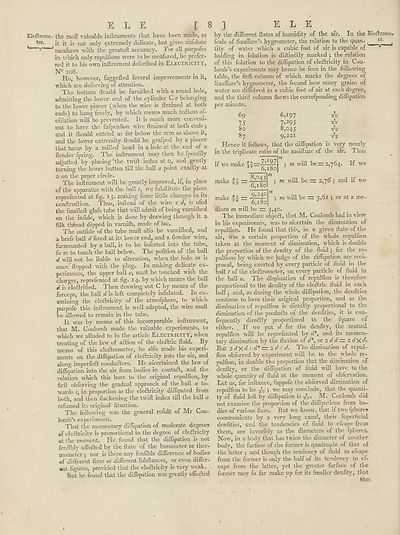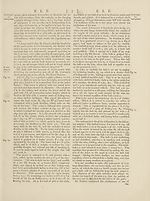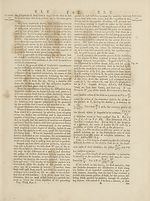Encyclopaedia Britannica, or, a Dictionary of arts, sciences, and miscellaneous literature : enlarged and improved. Illustrated with nearly six hundred engravings > Volume 8, ELE-FOR
(16) Page 8
Download files
Complete book:
Individual page:
Thumbnail gallery: Grid view | List view

E L E [8
Elcftromc-
ter.
the moil valuable inftruments that have been made, as
it it is not only extremely delicate, but gives abfolute
1 meafures with the greateft accuracy. For all purpofes
in which only repulhons were to be meafured, he prefer¬
red it to his own inftrument defcribed in Electricity,
N° 206.
He, however, fuggefted feveral improvements in it,
which are deferving of attention.
The bottom fhould be furnilhed with a round hole,
admitting the lower end of the cylinder C c belonging
to the lower pincer (when the wire is drained at both
ends) to hang freely, by which means much tedious ol-
cillaiion will be prevented. It is much more conveni¬
ent to have the fufpenfion wire drained at both ends j
and it diould extend as far below the arm as above it,
and the lower extremity ihould be grafped by a pincer
that turns by a milled head in a hole at the end of a
dender fpring. The indrument may then be fpcedily
adjuded by' placing the twid index at o, and gently
turning the lower button till the ball s point exactly at
o on the paper circle.
The indrument will be greatly improved, if, in place
of the apparatus with the ball /, we fubditute the piece
reprefented at fig. 15. making fome little changes in its
condruftion. Thus, indead of the wire c i/, is ufed
the fmalled glafs tube that will admit of being vamiihed
on the infide, which is done by drawing through it a
filk thread dipped in varnidi, made of lac.
The outfide of the tube mud alfo be varnidied, and
a brafs ball d fixed at its lower end, and a dender wire,
furmounted by a ball, is to be infertcd into the tube,
fo as to touch the ball below. The pofition of the ball
d will not be liable to alteration, when the hole m is
once dopped with the plug. In making delicate ex¬
periments, the upper ball c, mud be touched with the
charger, reprefented at fig. 14. by which means the ball
d is ele&rified. Then drawing out C by means of the
forceps, the ball d is left completely infulated. In ex¬
amining the cleftricity of the atmofphere, to which
purpofe this indrument is well adapted, the wire mud
be allowed to remain in the tube.
It was by means of this incomparable indrument,
that M. Coulomb made the valuable experiments, to
which we alluded to in the article Electricity, when
treating of the law of aftion of the electric fiuid. By
means of this electrometer, he alfo made his experi¬
ments on the didipation of eleftricity into the air, and
along imperfeft conductors. He afeertained the law of
didipation into the air from bodies in contafl, and the
relation which this bore to the original repulfion, by
fird obferving the gradual approach of the ball a to¬
wards /, in proportion as the electricity didipated from
both, and then dackening the twid index till the ball a
refumed its original fituatibn.
The following was the general refult of Mr Cou¬
lomb’s experiments.
That the momentary didipation of moderate degrees
a»f electricity is proportional to the degree of eleftricity
at the moment.' He found that the didipation is not
fen lib! y affetted by the date of the barometer or ther¬
mometer •, nor is there any fenfible difference of bodies
«f different fizes or different fubdances, or even differ¬
ent figures, provided that the electricity is very weak.
But lie found that the didipation was greatly affected
] E L E
by the different dates of humidity of the air. In the Elec'lrome.
fcale of Sauffure’s hygrometer, the relation to the quan- ^ .
tity of water which a cubic foot of air is capable of *
holding in dilution is didincdly marked j the relation
of this dilution to the didipation of eleclricity in Cou¬
lomb’s experiments may hence be feen in the following
table, the fird column of which marks the degrees of
Saudure’s hygrometer, the fecond how many grains of
water are dilfolved in a cubic foot of air at each degree,
and the third column {hews the correfponding didipation
per minute. .
69 6,197 tjV
75 7>295 tt
80 8,045 tV
87 9,221
Hence it follows, that the didipation is very nearly
in the triplicate ratio of the moidure of the air. Thus
if we make
* 6,180
8,045
make -£-£
6,180
9,24°|
5 m will 66=2,764. If we
m will- be = 2,76 ; and if we
„ , , m will be = 5,61 ; or at a me-
6,i8o| 7 0
dium m will be =r 3,40.
The immediate object, that M. Coulomb had in view
in his experiments, was to afeertain the diminution of
repulfion. He found that this, in a given date of the
air, was a certain proportion of the whole repulfion
taken at the moment of diminution, which is double
the proportion of the denfity of the fluid 5 for the re-
pulfions by which we judge of the didipation are reci¬
procal, being exerted by every particle of fiuid in the
ball t of the eleftrometer, on every particle of fluH in
the ball a. The diminution of repulfion is therefore
proportional to the denfity of the electric duid in each
ball; and, as during the whole didipation, the denfitics
continue to have their original proportion, and as the
diminution of repulfion is directly proportional to the
diminution of the products of the denfities, it is con-
fequently directly proportional to the Iquare of
either. If we put d for the denfity, the mutual
repulfion will be reprefented by d1, and its momen¬
tary diminution by the fiuxion oi d*, or i dd z=z 2 dxd.
But 2dxd : d1 — 2d \ d. The diminution of repul¬
fion obferved by experiment will be to the whole re¬
pulfion, in double the proportion that the diminution of
denfity, or the didipation of fiuid will have to the
whole quantity of duid at the moment of obfervation.
Let us, for inftance, fuppofe the obferved diminution of
repulfion to be ^ •, we may conclude, that the quanti¬
ty of fiuid loft by didipation is -g^-. M. Coulomb did
not examine the proportion of the difiipations from bo¬
dies of various fizes. But we know, that if two fpheres
communicate by a very long canal, their fuperficial
denfities, and the tendencies of fiuid to efcape from
them, are inverfely as the diameters of the fpheres.
Now, in a body that has twice the diameter of another
body, the furface of the former is quadruple of that of
the latter ; and though the tendency of fluid to efcape
from the former is only the half of its tendency to ef¬
cape from the latter, yet the greater furface of the
former may fo far make up for its fmallcr denfity, that
the
Elcftromc-
ter.
the moil valuable inftruments that have been made, as
it it is not only extremely delicate, but gives abfolute
1 meafures with the greateft accuracy. For all purpofes
in which only repulhons were to be meafured, he prefer¬
red it to his own inftrument defcribed in Electricity,
N° 206.
He, however, fuggefted feveral improvements in it,
which are deferving of attention.
The bottom fhould be furnilhed with a round hole,
admitting the lower end of the cylinder C c belonging
to the lower pincer (when the wire is drained at both
ends) to hang freely, by which means much tedious ol-
cillaiion will be prevented. It is much more conveni¬
ent to have the fufpenfion wire drained at both ends j
and it diould extend as far below the arm as above it,
and the lower extremity ihould be grafped by a pincer
that turns by a milled head in a hole at the end of a
dender fpring. The indrument may then be fpcedily
adjuded by' placing the twid index at o, and gently
turning the lower button till the ball s point exactly at
o on the paper circle.
The indrument will be greatly improved, if, in place
of the apparatus with the ball /, we fubditute the piece
reprefented at fig. 15. making fome little changes in its
condruftion. Thus, indead of the wire c i/, is ufed
the fmalled glafs tube that will admit of being vamiihed
on the infide, which is done by drawing through it a
filk thread dipped in varnidi, made of lac.
The outfide of the tube mud alfo be varnidied, and
a brafs ball d fixed at its lower end, and a dender wire,
furmounted by a ball, is to be infertcd into the tube,
fo as to touch the ball below. The pofition of the ball
d will not be liable to alteration, when the hole m is
once dopped with the plug. In making delicate ex¬
periments, the upper ball c, mud be touched with the
charger, reprefented at fig. 14. by which means the ball
d is ele&rified. Then drawing out C by means of the
forceps, the ball d is left completely infulated. In ex¬
amining the cleftricity of the atmofphere, to which
purpofe this indrument is well adapted, the wire mud
be allowed to remain in the tube.
It was by means of this incomparable indrument,
that M. Coulomb made the valuable experiments, to
which we alluded to in the article Electricity, when
treating of the law of aftion of the electric fiuid. By
means of this electrometer, he alfo made his experi¬
ments on the didipation of eleftricity into the air, and
along imperfeft conductors. He afeertained the law of
didipation into the air from bodies in contafl, and the
relation which this bore to the original repulfion, by
fird obferving the gradual approach of the ball a to¬
wards /, in proportion as the electricity didipated from
both, and then dackening the twid index till the ball a
refumed its original fituatibn.
The following was the general refult of Mr Cou¬
lomb’s experiments.
That the momentary didipation of moderate degrees
a»f electricity is proportional to the degree of eleftricity
at the moment.' He found that the didipation is not
fen lib! y affetted by the date of the barometer or ther¬
mometer •, nor is there any fenfible difference of bodies
«f different fizes or different fubdances, or even differ¬
ent figures, provided that the electricity is very weak.
But lie found that the didipation was greatly affected
] E L E
by the different dates of humidity of the air. In the Elec'lrome.
fcale of Sauffure’s hygrometer, the relation to the quan- ^ .
tity of water which a cubic foot of air is capable of *
holding in dilution is didincdly marked j the relation
of this dilution to the didipation of eleclricity in Cou¬
lomb’s experiments may hence be feen in the following
table, the fird column of which marks the degrees of
Saudure’s hygrometer, the fecond how many grains of
water are dilfolved in a cubic foot of air at each degree,
and the third column {hews the correfponding didipation
per minute. .
69 6,197 tjV
75 7>295 tt
80 8,045 tV
87 9,221
Hence it follows, that the didipation is very nearly
in the triplicate ratio of the moidure of the air. Thus
if we make
* 6,180
8,045
make -£-£
6,180
9,24°|
5 m will 66=2,764. If we
m will- be = 2,76 ; and if we
„ , , m will be = 5,61 ; or at a me-
6,i8o| 7 0
dium m will be =r 3,40.
The immediate object, that M. Coulomb had in view
in his experiments, was to afeertain the diminution of
repulfion. He found that this, in a given date of the
air, was a certain proportion of the whole repulfion
taken at the moment of diminution, which is double
the proportion of the denfity of the fluid 5 for the re-
pulfions by which we judge of the didipation are reci¬
procal, being exerted by every particle of fiuid in the
ball t of the eleftrometer, on every particle of fluH in
the ball a. The diminution of repulfion is therefore
proportional to the denfity of the electric duid in each
ball; and, as during the whole didipation, the denfitics
continue to have their original proportion, and as the
diminution of repulfion is directly proportional to the
diminution of the products of the denfities, it is con-
fequently directly proportional to the Iquare of
either. If we put d for the denfity, the mutual
repulfion will be reprefented by d1, and its momen¬
tary diminution by the fiuxion oi d*, or i dd z=z 2 dxd.
But 2dxd : d1 — 2d \ d. The diminution of repul¬
fion obferved by experiment will be to the whole re¬
pulfion, in double the proportion that the diminution of
denfity, or the didipation of fiuid will have to the
whole quantity of duid at the moment of obfervation.
Let us, for inftance, fuppofe the obferved diminution of
repulfion to be ^ •, we may conclude, that the quanti¬
ty of fiuid loft by didipation is -g^-. M. Coulomb did
not examine the proportion of the difiipations from bo¬
dies of various fizes. But we know, that if two fpheres
communicate by a very long canal, their fuperficial
denfities, and the tendencies of fiuid to efcape from
them, are inverfely as the diameters of the fpheres.
Now, in a body that has twice the diameter of another
body, the furface of the former is quadruple of that of
the latter ; and though the tendency of fluid to efcape
from the former is only the half of its tendency to ef¬
cape from the latter, yet the greater furface of the
former may fo far make up for its fmallcr denfity, that
the
Set display mode to:
![]() Universal Viewer |
Universal Viewer | ![]() Mirador |
Large image | Transcription
Mirador |
Large image | Transcription
Images and transcriptions on this page, including medium image downloads, may be used under the Creative Commons Attribution 4.0 International Licence unless otherwise stated. ![]()
| Permanent URL | https://digital.nls.uk/192263627 |
|---|
| Attribution and copyright: |
|
|---|
| Description | Ten editions of 'Encyclopaedia Britannica', issued from 1768-1903, in 231 volumes. Originally issued in 100 weekly parts (3 volumes) between 1768 and 1771 by publishers: Colin Macfarquhar and Andrew Bell (Edinburgh); editor: William Smellie: engraver: Andrew Bell. Expanded editions in the 19th century featured more volumes and contributions from leading experts in their fields. Managed and published in Edinburgh up to the 9th edition (25 volumes, from 1875-1889); the 10th edition (1902-1903) re-issued the 9th edition, with 11 supplementary volumes. |
|---|---|
| Additional NLS resources: |
|

